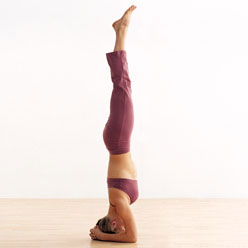|
|
|
What
is Salamba Sirsasana? |
|
In
Sanskrit salamba means supported and sirsa means head thus Salmba
sirsasana means supported headstand pose. It is an extremely powerful
asana that is referred as King of the Asana due to the overall effects
it imposes on the whole body. |
|
|
|
|
 Yoga and Ayurveda Tour
Yoga and Ayurveda Tour |
|
|
|
What
is the technique of Salamba Sirsasana? |
|
Facing the wall kneel down with your knees and leg together and
forearms resting on the floor with fingers interlocked. Arms can
be moved a little closer than shoulder for greater stability. Now
place the crown of your head on a blanket up against your
interlocked hands.
Curl
your toes under and straighten your legs, walking your feet in
toward your head, until your torso and hips are raised vertically
upward with tailbone or hips resting against the wall. Raise your
feet while bending knees in over your abdomen and with knees
remaining bent, bring your soles to rest on the wall. Then
straighten your legs upward, using the wall as a support while
pushing for ward in the hips so that things are brought in line
with the torso in the vertical. Try to lift up and out of your
shoulders. Hold this position for 10 seconds as a beginning
practitioner. Then |
 |
|
|
|
gradually
add 5 to 10 seconds onto your stay every day. With practice and experience
you can hold this pose for ten minutes. But increase your stay very
slowly. When you are ready, come down in as controlled manner as possible,
reversing your path taken into the position. |
|
|
|
What
are the benefits of practicing Salamba Sirsasana? |
|
This
asana leaves so many positive effects on the body and mind that it is
called King of the Asana. It enhances blood supply to the brain and calms
it. It helps relieve stress and mild depression. The regular practice of
this asana increases intellectual clarity, improves will power and
respiration. It stimulates the pituitary and pineal glands. It strengthens
the arms, legs, spine and lungs as well. It tones the abdominal organs and
Improves digestion. It helps relieve the symptoms of menopause. It helps
to cure minor (common cold, cough and sore throat) to major ailments like
asthma, infertility, insomnia, and sinusitis. |
|
|
|
What
are the cautions? |
|
Do not
practice this asana if you have back injury, headache, heart condition, high
blood pressure, and neck injury. Women should avoid this pose in
Menstruation and Pregnancy. If you have low blood pressure problem then do
not start practice with this pose. This asana should be practiced with care
and supervision of experienced teacher. |
|
|
|
|
|
|
|
|
|
|
|
|

